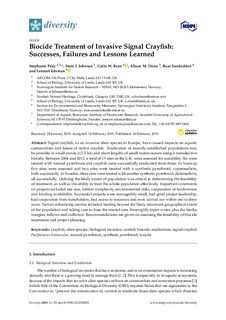Biocide Treatment of Invasive Signal Crayfish: Successes, Failures and Lessons Learned
| dc.contributor.author | Peay, Stephanie | |
| dc.contributor.author | Johnsen, Stein Ivar | |
| dc.contributor.author | Bean, Colin W. | |
| dc.contributor.author | Dunn, Alison M. | |
| dc.contributor.author | Sandodden, Roar | |
| dc.contributor.author | Edsman, Lennart | |
| dc.coverage.spatial | Europe, Norway, Sweden | nb_NO |
| dc.date.accessioned | 2019-07-09T12:58:47Z | |
| dc.date.available | 2019-07-09T12:58:47Z | |
| dc.date.created | 2019-02-28T14:41:41Z | |
| dc.date.issued | 2019 | |
| dc.identifier.issn | 1424-2818 | |
| dc.identifier.uri | http://hdl.handle.net/11250/2603943 | |
| dc.description.abstract | Signal crayfish, as an invasive alien species in Europe, have caused impacts on aquatic communities and losses of native crayfish. Eradication of recently established populations may be possible in small ponds (<2.5 ha) and short lengths of small watercourses using a nonselective biocide. Between 2004 and 2012, a total of 13 sites in the U.K. were assessed for suitability. Six were treated with natural pyrethrum and crayfish were successfully eradicated from three. In Norway, five sites were assessed and two sites were treated with a synthetic pyrethroid, cypermethrin, both successfully. In Sweden, three sites were treated with another synthetic pyrethroid, deltamethrin, all successfully. Defining the likely extent of population was critical in determining the feasibility of treatment, as well as the ability to treat the whole population effectively. Important constraints on projects included site size, habitat complexity, environmental risks, cooperation of landowners and funding availability. Successful projects were manageably small, had good project leadership, had cooperation from stakeholders, had access to resources and were carried out within one to three years. Factors influencing success included treating beyond the likely maximum geographical extent of the population and taking care to dose the treated area thoroughly (open water, plus the banks, margins, inflows and outflows). Recommendations are given on assessing the feasibility of biocide treatments and project-planning. crayfish; alien species; biological invasion; control; biocide; eradication; signal crayfish Pacifastacus leniusculus; natural pyrethrum; synthetic pyrethroid; toxicity | nb_NO |
| dc.language.iso | eng | nb_NO |
| dc.rights | Navngivelse 4.0 Internasjonal | * |
| dc.rights.uri | http://creativecommons.org/licenses/by/4.0/deed.no | * |
| dc.title | Biocide Treatment of Invasive Signal Crayfish: Successes, Failures and Lessons Learned | nb_NO |
| dc.type | Journal article | nb_NO |
| dc.type | Peer reviewed | nb_NO |
| dc.description.version | publishedVersion | nb_NO |
| dc.rights.holder | © 2019 by the authors | nb_NO |
| dc.subject.nsi | VDP::Zoologiske og botaniske fag: 480 | nb_NO |
| dc.subject.nsi | VDP::Zoology and botany: 480 | nb_NO |
| dc.source.volume | 11 | nb_NO |
| dc.source.journal | Diversity | nb_NO |
| dc.identifier.doi | 10.3390/d11030029 | |
| dc.identifier.cristin | 1681471 | |
| dc.relation.project | Andre: Norwegian Food Safety Authority | nb_NO |
| dc.relation.project | Andre: County Governor of Oslo and Akershus | nb_NO |
| dc.relation.project | Andre: County Governor of Telemark | nb_NO |
| dc.relation.project | Andre: Miljødirektoratet | nb_NO |
| cristin.unitcode | 7511,5,0,0 | |
| cristin.unitname | Lillehammer | |
| cristin.ispublished | true | |
| cristin.fulltext | original | |
| cristin.qualitycode | 1 |
Tilhørende fil(er)
Denne innførselen finnes i følgende samling(er)
-
Publikasjoner fra CRIStin - NINA [2364]
-
Scientific publications [1392]
Vitenskapelige artikler, kapitler og monografier i Open Access.

